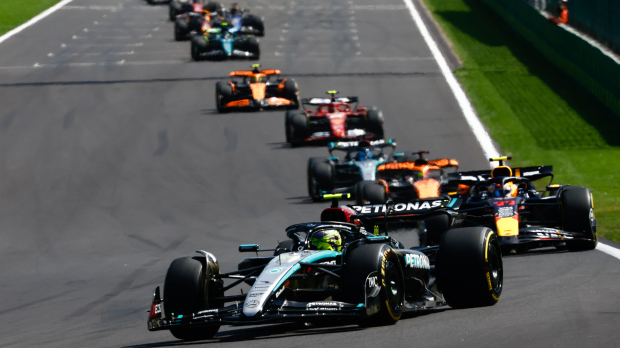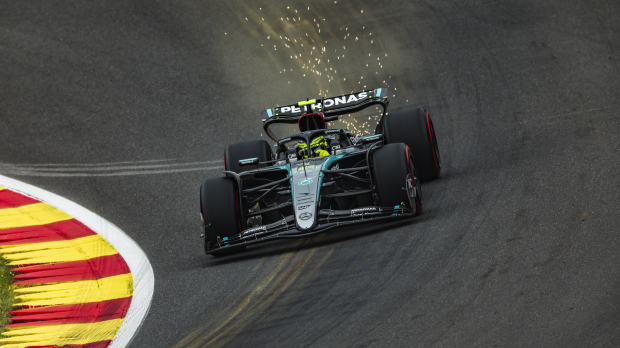When Lewis Hamilton returns to the Formula 1 paddock in Zandvoort later this week after the summer break, he will no doubt be hoping that Mercedes are able to maintain the momentum which has given him the chance once again do what he does best – win.
The seven-time world champions finally extended his record number of F1 victories to 104 and then 105 by winning the British Grand Prix at Silverstone in July before following it up with success at the Belgian Grand Prix at Spa three weeks later.
Those triumphs ended a run of two-and-a-half seasons away from the top step of the podium for the 38-year-old, and came as Mercedes reeled in frontrunners Red Bull alongside McLaren.
10 Things You May Not Know About Lewis Hamilton
Ever since F1 transitioned to its new era of ground-effect aerodynamics-based technical regulations at the start of the 2022 season, Mercedes had failed to provide Hamilton with a car in which he could challenge at the front.
A failed initial concept was followed by ignorance over the extent to which the team had followed the wrong track, before Hamilton undertook a series of setup experiments made physically gruelling by the cars’ tendency to violently bounce at high speed.
With Red Bull struggling to improve upon their own machinery – which had been dominant to an unprecedented across the two previous campaigns – from this spring onwards, those left in their dust were finally given the opportunity to make up serious ground. Belated it may have been, but Mercedes finally propelled themselves into contention again.
How has Hamilton managed to win again?

Hamilton’s latest two wins were not merely the result of the car’s improvement, of course. At neither of those two race weekends was the W15 the fastest on the grid – on race pace McLaren had the advantage and should be disappointed they were unable to turn it into a pair of victories.
But the team’s progress allowed Hamilton to make the difference. He drove with his typical intelligence, consistency and confidence on tyres to punish McLaren’s strategic errors and deliver the results he, his team and his fans had waited so long to see again.
Given the pressure to end his long victory drought, it would have been easy for Hamilton to panic in either scenario – to make the wrong tyre chance before the final stint at Silverstone (as Lando Norris did) or to make a mistake when hunted down by the quicker Oscar Piastri in the final stages at Spa. He didn’t, because this was Hamilton at his level-headed best.
This is not just a driver with more championship and victories behind him than any other, but one who seems once again laser-focused on forward momentum, unburdened by a fundamentally flawed car and disputes about how to improve it. If Mercedes are able to maintain the efficacy of their development plan, they will reap the rewards of Hamilton’s combination of speed and unflappability between now and the season finale in Abu Dhabi in December.
But Hamilton is now facing one of F1’s more quirky quandaries – hoping his current team can provide him with the platform to win as often as possible, while also hoping his future team is making better progress on next season’s car.
Why is Hamilton’s situation a bit strange?

That is the nature of the way F1’s driver market works – deals are often agreed so far in advance that, as in the case of Hamilton’s upcoming move to Ferrari for 2025, an entire season can pass before switches actually happen.
It means working as hard as possible with current colleagues to achieve the best results, while having no idea how well next season’s ones are preparing for your arrival, but hoping for the best. A process at once relatively awkward and entirely logical.
Some drivers are left in a kind of development purgatory where they cannot help influence the car they will drive for next year and beyond, and are also increasingly left out of key performance meetings with their current team as their departure draws nearer. Hamilton reflected as much earlier this year.
“I mean, it’s inevitable perhaps [that I’ll be left out of meetings with Mercedes] at one stage, but at the end of the day, no information that I would get this year will impact next year because I’m not in communication [with Ferrari],” Hamilton said. “Nothing passes hands until I start the season next year. And it takes time to develop things.”
2025 is the final season of F1’s current regulations before a huge reworking of both the cars and power units comes in for 2026, meaning next year’s vehicles are very likely to be lightly adapted evolutions of each team’s effort from this year, with focus increasingly centered on the new era as the gap until its start shortens.
That means both Mercedes and Ferrari’s level of performance in the final ten races of the season are likely to be pretty indicative of what they will be able to achieve in 2025, at least in its early stages.
For Hamilton, then, what Mercedes do next will dictate to what extent he is able to capitalise on his resurgence in the short-term. But what happens in the scarlet red garages will offer a far more accurate glimpse into his future and whether he is able to finally win an eighth championship.
Though he may not be able to collaborate with his new team until the contract changeover happens on 1 January, he will no doubt be hoping Ferrari demonstrate significant forward progress as well as Mercedes.





